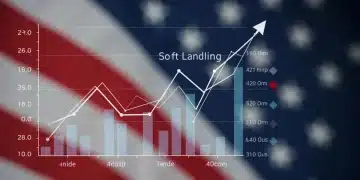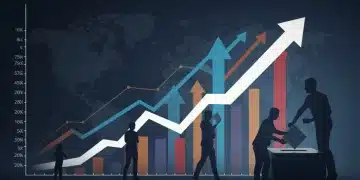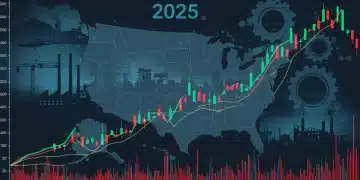2.5% GDP Growth in 2025: Impact on Your US Business
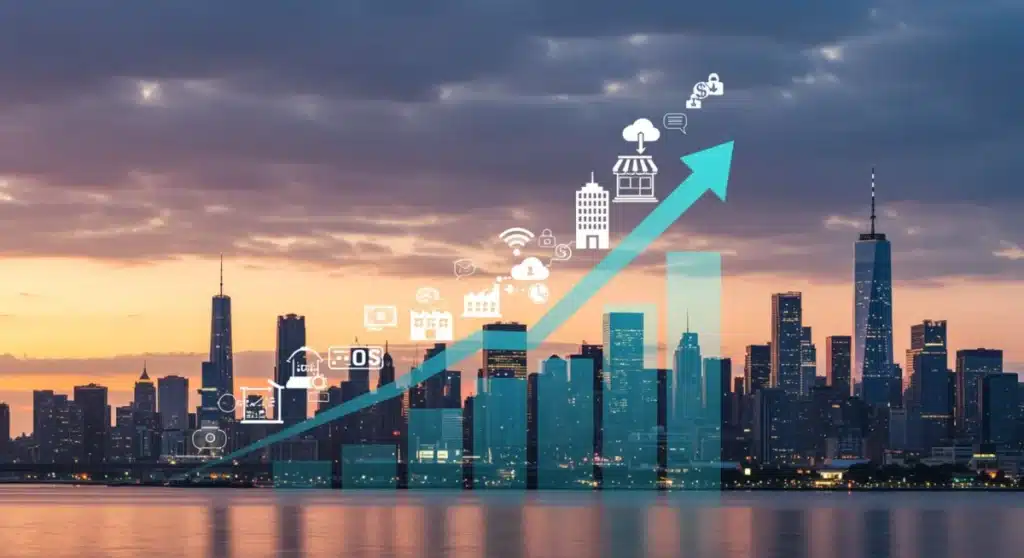
The projected 2.5% GDP growth in 2025 signals a period of economic expansion, influencing consumer behavior, investment patterns, and operational decisions for businesses across the United States.
As we look ahead, the projected 2.5% GDP growth in 2025 impact your business in profound ways, presenting both opportunities and challenges. This moderate yet steady expansion suggests a robust economic environment, diverging from the volatility of recent years. Understanding the nuances of this growth is critical for every American enterprise, from small startups to large corporations, to strategically position themselves for success.
Understanding the 2.5% GDP Growth Projection
The forecast of a 2.5% Gross Domestic Product (GDP) growth for 2025 in the United States is more than just a number; it’s a significant economic indicator. This figure suggests a healthy, sustainable expansion, moving beyond mere recovery to genuine progress. It reflects a broad consensus among economists regarding the nation’s economic trajectory, influenced by factors like consumer spending, business investment, government expenditure, and net exports.
A 2.5% growth rate is generally considered strong enough to create jobs, stimulate innovation, and improve living standards without necessarily triggering excessive inflation. It indicates a resilient economy capable of absorbing various shocks and maintaining momentum. For businesses, this translates into a more predictable operating environment, albeit one that still demands strategic agility.
Key Drivers of Projected Growth
- Consumer Spending: A cornerstone of the US economy, sustained consumer confidence and purchasing power are expected to bolster demand for goods and services. Wage growth and stable employment contribute significantly here.
- Business Investment: Companies are anticipated to increase capital expenditure, investing in technology, infrastructure, and expansion, driven by favorable economic conditions and potential for higher returns.
- Government Policies: Fiscal and monetary policies, including potential infrastructure spending and interest rate adjustments, will play a crucial role in shaping the economic landscape and supporting growth.
- Technological Advancements: Continuous innovation in sectors like AI, biotechnology, and renewable energy is expected to fuel productivity gains and create new market opportunities.
The convergence of these factors creates a fertile ground for businesses to thrive. However, it also means increased competition and the need for a clear understanding of market dynamics. Businesses that can adapt to evolving consumer preferences and leverage technological advancements will be best positioned to capitalize on this growth.
Impact on Consumer Behavior and Market Demand
A 2.5% GDP growth typically translates into a more confident consumer base, which directly influences spending patterns and market demand. When the economy is growing, people generally feel more secure in their jobs and future earnings, leading to an increased willingness to spend on both necessities and discretionary items. This shift in consumer sentiment can significantly alter the landscape for businesses across various sectors.
We can expect a rise in demand for higher-quality goods and services, as consumers might prioritize value and experiences over mere cost savings. This presents an opportunity for businesses that focus on premium offerings, personalized services, and innovative solutions. However, it also means that companies must remain competitive, continually refining their value propositions to capture this evolving demand.
Shifts in Consumer Priorities
- Increased Discretionary Spending: Sectors like travel, entertainment, dining, and luxury goods are likely to see a boost as consumers feel more comfortable allocating funds beyond essential needs.
- Focus on Experiences: Consumers are increasingly valuing experiences over material possessions. Businesses in hospitality, event management, and experiential retail could see significant growth.
- Sustainability and Ethics: A growing economy often allows consumers to align their purchases with their values. Businesses demonstrating strong commitments to sustainability, ethical sourcing, and social responsibility may gain a competitive edge.
Understanding these subtle yet powerful shifts in consumer behavior is paramount. Businesses need to conduct thorough market research to identify emerging trends and tailor their products, services, and marketing strategies accordingly. Failing to adapt could mean missing out on significant growth potential, even in a generally expanding economy.
Labor Market Dynamics and Talent Acquisition
The projected 2.5% GDP growth in 2025 will inevitably tighten the labor market, creating both opportunities and challenges for businesses in talent acquisition and retention. A growing economy typically leads to lower unemployment rates, as companies expand and hire more staff to meet increased demand. While this is positive for the overall workforce, it means employers will face stiffer competition for skilled labor.
Businesses will need to re-evaluate their recruitment strategies, focusing on attractive compensation packages, robust benefits, and a compelling company culture to stand out. The emphasis will shift from simply filling positions to attracting and retaining top talent, which is crucial for maintaining productivity and innovation in a competitive environment.
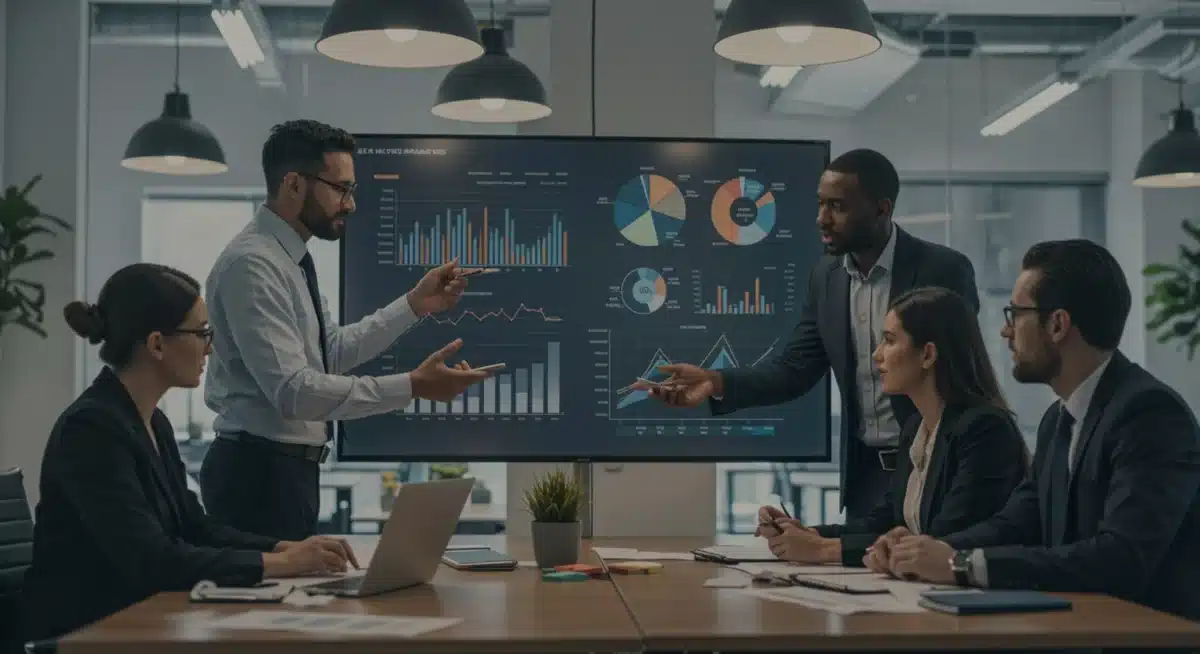
Strategies for a Tight Labor Market
- Competitive Compensation: Regularly benchmark salaries and benefits to ensure they are attractive compared to industry standards. This includes not just base pay, but also bonuses, equity, and healthcare.
- Upskilling and Reskilling: Invest in training programs for current employees to develop new skills, not only enhancing their capabilities but also boosting morale and loyalty. This can also help address skill gaps internally.
- Flexible Work Arrangements: Offer remote work options, flexible hours, and other work-life balance initiatives to appeal to a broader talent pool and improve employee satisfaction.
- Employer Branding: Cultivate a strong employer brand that highlights company values, positive work environment, and growth opportunities. This attracts candidates who align with the organization’s mission.
Beyond recruitment, retention becomes equally critical. High employee turnover can be costly, eroding productivity and institutional knowledge. Businesses must focus on creating an engaging and supportive work environment where employees feel valued and have clear paths for career progression. Proactive human resource strategies will be key to navigating a robust labor market effectively.
Investment, Innovation, and Capital Allocation
A 2.5% GDP growth projection often correlates with increased business confidence, leading to higher levels of investment and a greater appetite for innovation. Companies, anticipating stronger consumer demand and a more stable economic outlook, are more likely to allocate capital towards expansion, research and development, and technological upgrades. This investment cycle can create a virtuous circle, further propelling economic growth.
For businesses, this means a strategic examination of their capital allocation. Where should resources be directed to maximize returns in a growing economy? The answer often lies in areas that enhance efficiency, improve product offerings, or open new market segments. Innovation, particularly in digital transformation and automation, will be a significant focus, as companies seek to gain a competitive edge and optimize operations.
Strategic Investment Areas
- Technology Infrastructure: Upgrading IT systems, cloud computing capabilities, and cybersecurity measures to support scaling operations and protect valuable data.
- Automation and AI: Investing in automated processes and artificial intelligence solutions to increase productivity, reduce operational costs, and free up human capital for more complex tasks.
- Sustainability Initiatives: Allocating capital towards environmentally friendly practices and products, which can not only attract eco-conscious consumers but also lead to long-term cost savings and regulatory compliance.
- Market Expansion: Exploring new geographic markets or product lines, leveraging the overall economic growth to diversify revenue streams and reach new customer bases.
The availability of capital, potentially at more favorable interest rates if economic stability persists, could also encourage borrowing for significant projects. Businesses should carefully evaluate potential investments, conducting thorough cost-benefit analyses to ensure alignment with long-term strategic goals. Prudent capital allocation during a growth period can lay the foundation for sustained success.
Supply Chain Resilience and Global Trade Impacts
The anticipated 2.5% GDP growth in 2025 will undoubtedly place increased pressure on global supply chains, necessitating greater resilience and strategic planning. A growing economy typically means higher demand for raw materials, components, and finished goods, which can strain existing supply networks. Businesses that have not invested in diversifying their supply chains or improving their logistics might face bottlenecks and increased costs.
Moreover, global trade dynamics will continue to evolve, influenced by geopolitical factors, trade agreements, and shifts in manufacturing hubs. US businesses must remain agile, monitoring international developments and adapting their sourcing and distribution strategies accordingly. Building robust, diversified supply chains will be crucial not just for efficiency but for business continuity.
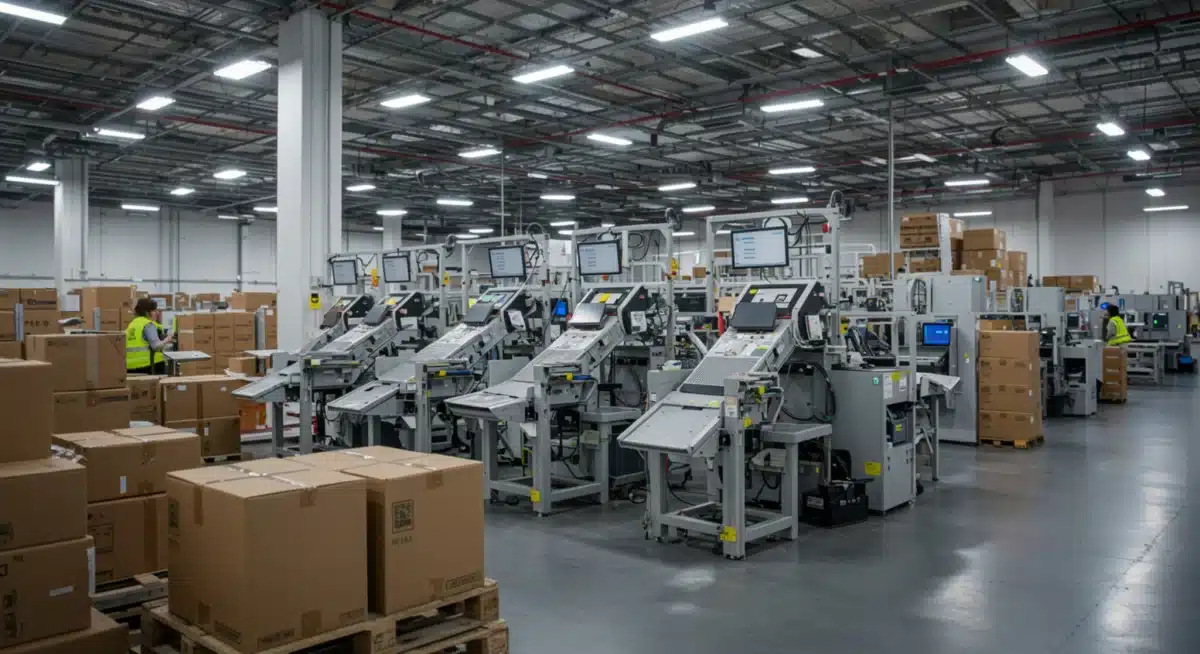
Enhancing Supply Chain Agility
- Diversified Sourcing: Reduce reliance on single suppliers or geographic regions by establishing relationships with multiple vendors across different countries.
- Technology Adoption: Implement advanced supply chain management software, AI for demand forecasting, and real-time tracking systems to improve visibility and responsiveness.
- Local and Nearshoring: Explore options for bringing production or sourcing closer to home to mitigate geopolitical risks and reduce transportation costs and lead times.
- Inventory Optimization: Balance the need for sufficient stock to meet demand with the costs of holding excess inventory, using data analytics to fine-tune inventory levels.
The interplay of domestic growth and international trade policies will define the operational environment for many businesses. Proactive risk assessment and strategic partnerships will be essential for navigating potential disruptions and leveraging global opportunities. Businesses that master supply chain resilience will gain a significant competitive advantage.
Sector-Specific Opportunities and Challenges
While a 2.5% GDP growth offers a generally positive outlook, its impact will not be uniform across all sectors. Each industry faces unique opportunities and challenges influenced by specific market dynamics, consumer trends, and regulatory environments. Understanding these sector-specific nuances is vital for businesses to tailor their strategies effectively and maximize their potential gains.
For instance, technology and renewable energy sectors are likely to see accelerated growth due to ongoing innovation and increasing demand for sustainable solutions. Conversely, traditional manufacturing or retail sectors might need to innovate more aggressively to stay competitive against digital disruptors and evolving consumer preferences. The key is to identify where your business stands within this broader economic tide.
Varying Sectoral Outlooks
- Technology Sector: Expected to boom with continued investment in AI, cloud computing, and cybersecurity, driven by business and consumer demand for advanced solutions.
- Healthcare: Will likely see steady growth due to an aging population and ongoing advancements in medical technology, though cost pressures remain a challenge.
- Retail and Hospitality: Benefiting from increased consumer spending, but facing pressure to enhance digital integration, personalized experiences, and sustainable practices.
- Manufacturing: Growth tied to domestic demand and global supply chain adjustments, with an emphasis on automation and advanced manufacturing techniques for efficiency.
Businesses must conduct a detailed analysis of their specific industry’s outlook within the context of the broader economic growth. This includes assessing competitive landscapes, understanding regulatory changes, and identifying emerging technologies that could either disrupt or enhance their operations. Strategic foresight and adaptability will be paramount for capitalizing on sector-specific opportunities while mitigating associated risks.
Strategic Planning for 2025: Adapting to Growth
For businesses to truly harness the potential of a projected 2.5% GDP growth in 2025, proactive and adaptive strategic planning is indispensable. This isn’t merely about riding the wave of economic expansion; it’s about anticipating market shifts, optimizing internal operations, and positioning the business for sustainable long-term success. A “business as usual” approach could lead to missed opportunities or even falling behind more agile competitors.
Effective strategic planning involves a holistic review of all business functions, from finance and marketing to human resources and operations. It requires a clear vision, measurable goals, and the flexibility to adjust plans as new economic data emerges. The aim is to build resilience and foster innovation, ensuring the business is not just surviving but thriving in a dynamic economic landscape.
Elements of an Adaptive Strategy
- Market Intelligence: Continuously monitor economic indicators, consumer trends, and competitive activities to inform decision-making and identify new opportunities.
- Financial Prudence: Maintain healthy cash reserves, manage debt effectively, and allocate capital strategically to support growth initiatives while safeguarding against potential downturns.
- Talent Development: Invest in employee training, leadership development, and succession planning to ensure the workforce is equipped to meet future demands and challenges.
- Digital Transformation: Accelerate the adoption of digital technologies to improve efficiency, enhance customer experience, and unlock new business models.
- Risk Management: Identify and assess potential economic, operational, and geopolitical risks, developing contingency plans to mitigate their impact.
Ultimately, the 2.5% GDP growth in 2025 offers a powerful tailwind for businesses. However, realizing its full potential demands more than passive observation. It requires a commitment to continuous improvement, strategic foresight, and an unwavering focus on adaptability. Businesses that embrace these principles will be well-prepared to translate economic growth into tangible success.
| Key Aspect | Description of Impact |
|---|---|
| Consumer Spending | Expected increase in discretionary spending and demand for premium experiences due to higher confidence. |
| Labor Market | Tighter job market, requiring competitive compensation and enhanced talent retention strategies. |
| Business Investment | Increased capital allocation towards technology, innovation, and expansion projects. |
| Supply Chains | Pressure for greater resilience, diversification, and technological adoption to meet demand. |
Frequently Asked Questions About 2025 GDP Growth
Small businesses will likely benefit from increased consumer spending and easier access to capital. However, they might face greater challenges in attracting and retaining talent amidst a tighter labor market. Strategic niche identification and efficient digital marketing will be crucial for their success.
Sectors like technology (AI, cloud computing), renewable energy, healthcare, and discretionary consumer goods (travel, entertainment) are anticipated to experience significant benefits. These industries often thrive during periods of sustained economic expansion and innovation.
While 2.5% growth is generally considered sustainable, any rapid increase in demand not matched by supply could lead to inflationary pressures. Monitoring central bank policies and supply chain stability will be key to understanding potential inflation risks throughout 2025.
Businesses should focus on value-driven marketing, highlighting quality, experiences, and sustainability. Digital channels will remain critical, but personalized messaging and responsive customer service will be essential to capture the confident, yet discerning, consumer.
Technology is pivotal. Businesses should invest in automation for efficiency, AI for data analytics and customer insights, and robust digital infrastructure. Embracing digital transformation can enhance productivity, optimize customer engagement, and unlock new revenue streams in a growing economy.
Conclusion
The projected 2.5% GDP growth for 2025 presents a compelling narrative of economic expansion and stability for businesses across the United States. This environment fosters increased consumer confidence, encourages strategic business investment, and necessitates a proactive approach to talent acquisition and supply chain management. While opportunities abound, navigating the evolving market dynamics, competitive pressures, and potential inflationary concerns requires careful planning and adaptability. Businesses that embrace innovation, prioritize customer value, and cultivate resilient operational frameworks will be best positioned to not only survive but thrive in this promising economic chapter, translating national growth into individual enterprise success.
